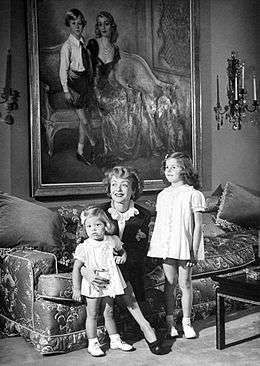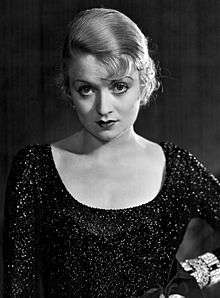Constance Bennett
| Constance Bennett | |
|---|---|
|
Bennett in Rockabye (1932) | |
| Born |
October 22, 1904 New York City, New York, U.S. |
| Died |
July 24, 1965 (aged 60) Fort Dix, New Jersey, U.S. |
| Cause of death | Cerebral hemorrhage |
| Resting place | Arlington National Cemetery |
| Occupation | Actress |
| Years active | 1916–1965 |
| Spouse(s) |
Chester Hirst Moorhead (m. 1921; div. 1923) Philip Morgan Plant (m. 1925; div. 1929) Henri de la Falaise (m. 1931; div. 1940) Gilbert Roland (m. 1941; div. 1946) John Theron Coulter (m. 1946–65) |
| Children | 4 |
| Parent(s) |
Richard Bennett Adrienne Morrison |
Constance Campbell Bennett (October 22, 1904 – July 24, 1965) was an American film actress and a major Hollywood star during the 1920s and 1930s. During the early 1930s, she was for a time the highest-paid actress in Hollywood, and one of the most popular. Bennett frequently played society women, focusing on melodramas in the early 1930s and then taking more comedic roles in the late 1930s and 1940s. She is best known today for her leading roles in Topper (1937), in which she co-starred with Cary Grant; its sequel Topper Takes a Trip (1938); and What Price Hollywood? (1932), its subsequent remakes for the 1937 film A Star is Born. Bennett also had a prominent supporting role in Greta Garbo's last film, Two-Faced Woman (1941).[1]
She was the daughter of stage and silent film star Richard Bennett, and the older sister of actress Joan Bennett.[1]
Early life
Bennett was born in New York City, the daughter of actor Richard Bennett and actress Adrienne Morrison, whose father was the stage actor Lewis Morrison (Morris W. Morris), a performer of English, Spanish, Jewish, and African ancestry.[2] Constance's younger sister was prominent actress Joan Bennett. Their other sibling was actress/dancer Barbara Bennett.
Career
After some time spent in a convent, Bennett went into the family business. Independent, cultured, ironic and outspoken, Constance, the first Bennett sister to enter motion pictures, appeared in New York-produced silent movies before a meeting with Samuel Goldwyn led to her Hollywood debut in Cytherea (1924). She abandoned a burgeoning career in silents for marriage to Philip Plant in 1925, but resumed her film career after their divorce, with the advent of talking pictures (1929), and with her delicate blonde features and glamorous fashion style, she quickly became a popular film star.
In the early 1930s, Bennett was frequently among the top actresses named in audience popularity and box-office polls. For a short time, she was the highest-paid actress in Hollywood. So successful was Bennett during this time, that RKO, Bennett's home studio at the time, controlled the careers of actresses Ann Harding and Helen Twelvetrees in a similar manner, hoping to duplicate Bennett's success.[3] In 1931, a short-lived contract with Metro-Goldwyn-Mayer earned her $300,000 for two movies which included The Easiest Way and made her one of the highest paid stars in Hollywood. Warner Brothers paid her the all-time high salary of $30,000 a week for Bought! in 1931.[4] Richard Bennett, her father, was also cast in this film. The next year she moved to RKO, where she acted in What Price Hollywood? (1932), directed by George Cukor, an ironic and at the same time tragic behind-the-scenes looks at the old Hollywood studio system, in which she portrayed waitress Mary Evans, who becomes a movie star. Lowell Sherman co-starred as the film director who discovers her, and Neil Hamilton as the wealthy playboy she marries. It was a critical and box office hit at the time of its release. The film Morning Glory had been written with Bennett in mind for the lead role, but producer Pandro S. Berman gave the role to Katharine Hepburn, who won an Academy Award for her performance.
Bennett next showed her versatility in the likes of Our Betters (1933), Bed of Roses (1933) with Pert Kelton, After Tonight (1933) (co-starring with future husband Gilbert Roland), The Affairs of Cellini (1934), After Office Hours (1935) with Clark Gable, the original Topper (1937, in a career standout as Marian Kerby opposite Cary Grant, a role she repeated in the 1939 sequel, Topper Takes a Trip), the ultimate madcap family comedy Merrily We Live (1938) and Two-Faced Woman (1941, supporting Greta Garbo).
By the 1940s, Bennett was working less frequently in film but was in demand in both radio and theatre. Shrewd investments had made her a wealthy woman, and she founded a cosmetics and clothing company.
After World War II
She had a major supporting role in Warner Bros.'s The Unsuspected (1947) opposite Claude Rains, in which she played the program director who helps prove that Rains is guilty of murder. She made no films from the early 1950s until 1965 when she made a comeback in the film Madame X (released posthumously in 1966) playing Lana Turner's mother-in-law. Shortly after filming was completed, Bennett collapsed and died from a cerebral hemorrhage at the age of 60.
In recognition of her military contributions, and as the wife of Theron John Coulter, who had achieved the rank of brigadier general, she was buried in Arlington National Cemetery. Coulter died in 1995 and was buried with her.
Bennett has a star on the Hollywood Walk of Fame for her contribution to motion pictures, at 6250 Hollywood Boulevard, a short distance from the star of her sister, Joan.
Personal life

Bennett was married five times.
- In 1921 Bennett eloped with Chester Hirst Moorehead of Chicago, the son of a surgeon. The marriage was annulled in 1923.
- Bennett eloped with millionaire socialite Philip Morgan Plant (died 1941) in 1925; they divorced in 1929. In 1932, Bennett brought back from Europe a three-year-old child, whom she claimed to have adopted and named Peter Bennett Plant. In 1942, however, during a battle over a large trust fund established to benefit any descendants of her former husband, Bennett announced that her adopted son actually was her natural child by Plant, born after the divorce and kept hidden in order to ensure that the child's biological father did not get custody. During the court hearings, the actress told her former mother-in-law and her husband's widow that "if she got to the witness stand she would give a complete account of her life with Plant. The matter was settled out of court."[5][6]
- She captured numerous headlines in 1931, when she married one of Gloria Swanson's former husbands, Henri le Bailly, the Marquis de La Coudraye de La Falaise (1898–1972), a French nobleman and film director. Bennett and de la Falaise founded Bennett Pictures Corp. and co-produced two films which were the last filmed in Hollywood in the two-strip Technicolor process, Legong: Dance of the Virgins (1935) filmed in Bali, and Kilou the Killer Tiger (1936), filmed in Indochina. They were divorced in Reno, Nevada in 1940.[7]
- In 1941, Bennett married the actor Gilbert Roland, with whom she had two daughters, Lorinda and Christina (a.k.a. Gyl). They were divorced in 1946.
- In June 1946, Bennett married US Air Force Colonel (later Brigadier General) John Theron Coulter (1912–1995). After her marriage, she concentrated her efforts on providing relief entertainment to US troops still stationed in Europe, winning military honors for her services.
Bennett was the aunt of Morton Downey Jr., the son of Constance's sister Barbara.
Filmography
- The Valley of Decision (1916)
- Reckless Youth (1922)
- Evidence (1922)
- What's Wrong with the Women? (1922)
- Cytherea (1924)
- Into the Net (1924)
- Wandering Fires (1925)
- The Goose Hangs High (1925)
- Code of the West (1925)
- My Son (1925)
- My Wife and I (1925)
- The Goose Woman (1925)
- Sally, Irene and Mary (1925)
- The Pinch Hitter (1925)
- Married ? (1926)
- Rich People (1929)
- This Thing Called Love (1929)
- Son of the Gods (1930)
- Three Faces East (1930)
- Common Clay (1930)
- Sin Takes a Holiday (1930)
- The Easiest Way (1931)
- Born to Love (1931)
- The Common Law (1931)
- Bought! (1931)
- Screen Snapshots (1932) (short subject)
- Lady with a Past (1932)
- What Price Hollywood? (1932)
- Two Against the World (1932)
- Rockabye (1932)
- Our Betters (1933)
- Bed of Roses (1933)
- After Tonight (1933)
- Moulin Rouge (1934)
- The Affairs of Cellini (1934)
- Outcast Lady (1934)
- After Office Hours (1935)
- Legong (1935) producer only
- Starlit Days at the Lido (1935) (short subject)
- Everything Is Thunder (1936) (British)
- Ladies in Love (1936)
- Daily Beauty Rituals (1937) (short subject)
- Topper (1937)
- Merrily We Live (1938)
- Service de Luxe (1938)
- Topper Takes a Trip (1938)
- Tail Spin (1939)
- Escape to Glory (1940)
- Law of the Tropics (1941)
- Picture People No. 2: Hollywood Sports (1941) (short subject)
- Two-Faced Woman (1941)
- Wild Bill Hickok Rides (1942)
- Hedda Hopper's Hollywood No. 5 (1942) (short subject)
- Sin Town (1942)
- Madame Spy (1942)
- Paris Underground (1945)
- Centennial Summer (1946)
- The Unsuspected (1947)
- Smart Woman (1948)
- Angel on the Amazon (1948)
- As Young as You Feel (1951)
- It Should Happen To You (1954)
- Madame X (1966)
References
- 1 2 Kellow, Brian (2004). The Bennetts: An Acting Family. Lexington, Kentucky: University Press of Kentucky. ISBN 978-0813123295.
- ↑ Downey, Phil, A Black, Jewish Officer in the Civil War, Jewish-American History Documentation Foundation. Retrieved May 8, 2013.
- ↑ Leading Ladies.
- ↑ The Warner Bros Story - Clive Hirschhorn p. 106; ISBN 0-517-53834-2
- ↑ September 14, 1942, Time
- ↑ November 29, 1943, Time
- ↑ "Famous people divorced in Reno (new)". renodivorcehistory.org. Retrieved 2015-10-15.
External links
| Wikimedia Commons has media related to Constance Bennett. |
- Constance Bennett Website
- Constance Bennett at the Internet Movie Database
- Constance Bennett at the TCM Movie Database

- Constance Bennett at the Internet Broadway Database

- Constance Bennett at AllMovie
- Constance Bennett at Find a Grave
- Constance Bennett Photo Gallery
- Photographs and literature
